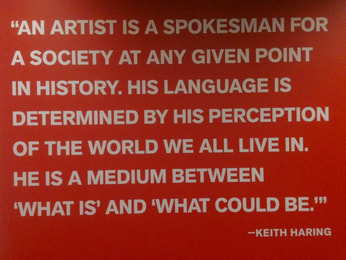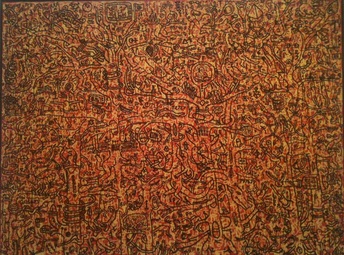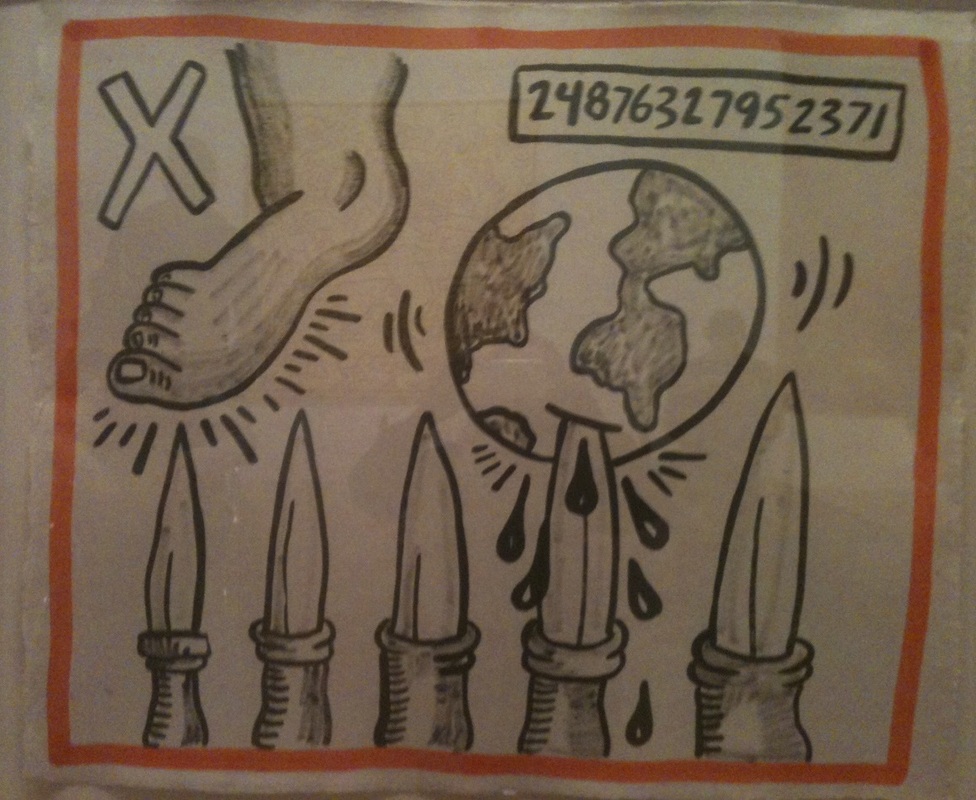 By Hannah Onstad This exhibit appeared in the de Young Museum, Golden Gate Park, San Francisco, between November 8, 2014 – February 16, 2015 At the start of "The Political Line" visitors are met with a quote from the artist. Followed by an early work from 1978 when the artist was 20 titled Everybody Knows Where Meat Comes From, It Comes From the Store, a ceiling-to-floor scroll in black on white with red splattered throughout. From these initial words, we immediately understand the artist as activist. However, after that, there is no further text from the artist within the show, save a single notebook entry in a journal. Haring’s energetic body of work speaks for itself. Keith Haring (May 4, 1958 – February 16, 1990) imbued his work with meaning tackling significant issues of the day—AIDS, greed, capitalism, war, and environmental concerns. His work isn’t subtle, and while his themes aren't always new, yet Haring’s work holds up and feels as striking, arresting, and relevant today as it was thirty years ago. Haring’s recognizable figures are pared down to nothing more than an outline devoid of details, yet these figures, which are sustained throughout his work, are expressive, limber, provocative and versatile. Consistently throughout his dozen years of paintings, it is the figure that tells the story. The figures appear alone, in groups, actively engaged with life, sometimes reflecting the injustices Haring sees, sometimes expressing the beauty of life and love—always accessible and elemental in their humanity. Haring himself was as equally recognizable as his art in the 1980s. His relationships with Andy Warhol, Madonna, and Jean-Michel Basquiat are explored, though not in as much detail as I would have liked to see. The show does include A Pile of Crowns for Jean-Michel Basquiat, which Haring did upon Basquiat’s death, one of two large triangular canvases, along with Silence=Death, the former pointing upward and the latter downward, both done in 1988. One of the more nuanced canvases is one he completed the year before he died titled The Last Rainforest. In it, Haring overlays a more detailed narrative in black outline over a pale layer of abstraction in the background creating a sense of chaos, yet coherent as a whole. The canvas evokes a feeling of the animals, people, and trees in the foreground struggling for recognition amid the almost unseen forces in the background. The symbolism in Haring’s ecocide and capitalism works are part of a broader language of iconography used by other artists at the time, and evocative of some of the work of Philip Guston and Manuel Ocampo—picking up on themes of colonialism, the Catholic Church, and the new widespread global capitalism with its wake of environmental destruction. Driving home on Mission Street after the show, I couldn't help but feel the influence of Haring on a newer generation of contemporary graffiti artists like Zio Ziegler whose work shows some affinity to Haring’s almost tribal patterning. Despite the heavy themes, The Political Line exhibit feels uplifting. The vivid color, bold lines, dashes that convey movement and dance, all manage to impart a sense that mankind is in this together, as Haring reminds us, to reflect on what we do, make change happen, and celebrate the good times. The Last Rainforest, Keith Haring, left.
Detail from Ecocide, Keith Haring, right. The Political Line, de Young Museum, through February 16, 2015
0 Comments
|
About this BlogWritten by Hannah Onstad, unless specified otherwise. Occasionally, posts here have been previously published elsewhere, and if so, that is noted at the top. Archives
June 2020
Categories |


